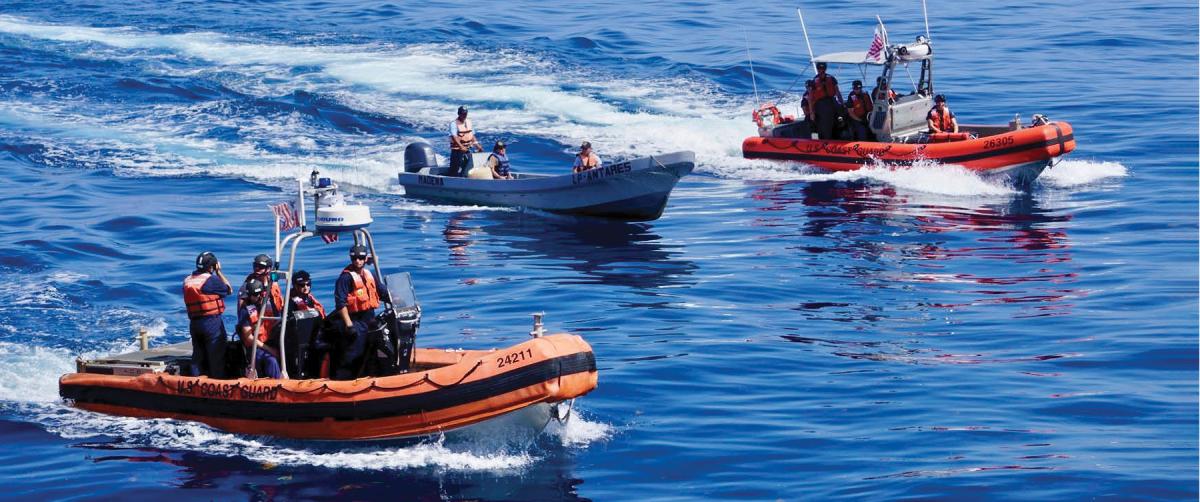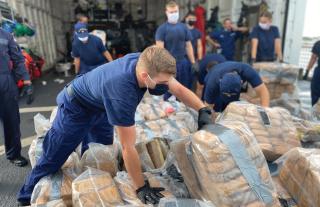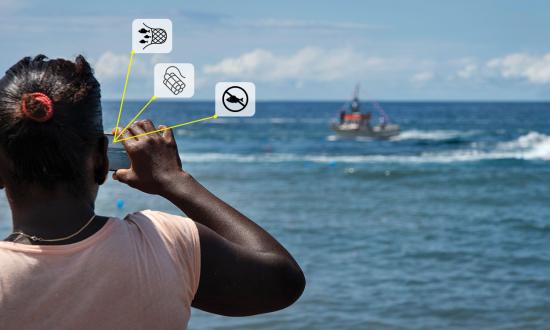On 9 June 2019, a Philippine-flagged fishing vessel, the Gem-Ver 1, was rammed and partially sunk by the Chinese-flagged fishing vessel Yuemaobinyu 42212.1 Not only was the Chinese vessel within the Philippines’ internationally recognized exclusive economic zone (EEZ), but there was also strong evidence to suggest it was there as part of China’s maritime militia.2
The world’s population relies on fish for 20 percent of its protein, but as these stocks dwindle as a result of illegal, unreported, and unregulated (IUU) fishing, the race for sea-based nutrition has become more contentious.3 China alone makes up 50 percent of worldwide fish consumption, pushing its 4,600-vessel distant-water fleet—the world’s largest—to venture farther each year.4 Thus, China’s distant-water fleet poses a growing transnational threat to security around the world. This challenge cannot be effectively countered through traditional means alone. Instead, the United States and its allies should champion the sovereignty of partner nations through law enforcement efforts such as shiprider, bilateral, and information-sharing agreements.
Threat to Human Security
IUU fishing describes an array of harmful fishing practices, including vessels and fishermen who break existing fisheries laws and regulations and harmful practices in EEZs or international waters where no state or international body has yet imposed restrictions for responsible management.5 In countries with weaker governance, foreign exploitation of fisheries has pushed artisanal fishermen into criminal activities such as narcotrafficking and piracy.5
While every coastal state has contributed to the decline of fish stocks to some degree, none surpass China’s impact. The 2019 IUU Fishing Index, which ranks coastal countries worldwide based on their vulnerability to, practice of, and response to harmful fishing practices, listed China as the top global offender, scoring 40 percent worse than the worldwide average.6 Furthermore, the United Nations found China’s distant-water fleet to have been underreporting their global catch size by a factor of 12.7 Countries in the Indo-Pacific region have lost patience with these illegal practices and have begun to push back.8
China’s Maritime Militia
Many Chinese-flagged fishing vessels and their crews are members of the People’s Armed Forces Maritime Militia. Beijing describes this organization as “an armed mass organization composed of civilians retaining their regular jobs,” and it is a component of the Chinese armed forces.9 While members of this force can operate as independent civilian fishermen, it receives special training and funding to support military objectives, provides surveillance and presence, and completes other tasking as requested.10 Experts believe the Yuemaobinyu 42212 was carrying out this kind of assignment on the night it rammed the Gem-Ver 1.11 While the overall coordination and direction of the force is poor, militia vessels have been known to serve a “backstop” function, calling in China Coast Guard and People’s Liberation Army Navy (PLAN) vessels if their operations are impeded by foreign authorities.12
While the omnipresence of militia vessels in disputed areas can be intimidating for artisanal fishermen, the militia’s lack of professionalization increases the risk for conflict. As the Asia Maritime Transparency Initiative notes, “the same factors that make the maritime militia a deniable force (its civilian crews and dual-use technology) also raise the risk of accidents and escalations.”13 For example, the sinking of the Gem-Ver 1 pushed former Philippine President Rodrigo Duterte to distance himself from his once-warm friendship with China’s President Xi Jinping.14
The South China Sea
The South China Sea is one of the planet’s most intensively fished and disputed maritime regions. The source of 12 percent of the world’s catch in 2015, its stocks have been depleted by 70–95 percent since the 1950s.15 There are numerous overlapping claims of sovereignty, the most contentious of which revolves around China’s so-called nine-dash line.
The nine-dash line originated from a 1935 map that claimed China had historic rights to the vast majority of the South China Sea, far beyond its own borders.16 However, China has never clarified either the coordinates of the dashes or the extent of its right to sovereignty.17 As a result, many of China’s actions within the claimed area have been inconsistent.18 Although the Permanent Court of Arbitration in the Hague unequivocally rebuffed China’s claim to these waters in 2016, stating it had no basis in international law, the Chinese government rejected the judgment and has continued to claim authority and jurisdiction over the disputed region.19
The Indian Ocean
The Indian Ocean, which accounts for 14 percent of the reported global fish catch, has seen both a lack of regulation and a recent spike in unreported fishing.20 In countries that struggle with poor governance, foreign-flagged fishing fleets have taken advantage of the lax regulation, either entering these nations’ waters without permission or purchasing fishing rights in return for debt forgiveness or cash put into the hands of corrupt officials.21
In the Indian Ocean’s international waters, the primary factor contributing to the spike in overfishing is the arrival of a Chinese-flagged fleet of more than 100 vessels taking advantage of a gap in regulation to target squid in international waters. Because the squid are a primary food source for both tuna and swordfish, Chinese overfishing of squid in the Indian Ocean could cause the tuna and swordfish fisheries to decline.22 Such a change could spark conflict—especially with China’s longtime rival, India.
Build a Network of Counter-IUU Allies
Distant-water fleets target areas where governance is weakest and security is already threatened.23 The United States alone cannot curb harmful fishing practices in the Indo-Pacific region—it must engage with partners and allies. To accomplish this goal, its actions should be based on two principles: 1) that most states in the region do not wish to be forced to choose sides in a great power conflict, and 2) that these nations, many of whom were the victims of colonization or imperialism in the recent past, prefer to take the lead in defending their own sovereignty.
The U.S. Coast Guard and Navy play key roles at home in protecting sea-based resources, as well as abroad in capacity-building and shiprider programs. These organizations can buttress the legitimate sovereignty claims of partner nations by offering to create new bilateral agreements, as well as expanding shiprider programs. Furthermore, the United States should encourage the other Quad+ members (Australia, India, Japan, Vietnam, Indonesia, Taiwan, Singapore, France, and the United Kingdom) to build similar programs in the region, and to share intelligence and satellite data that contribute to detecting and preventing harmful fishing practices.
When countries have a will to enforce fisheries regulations but lack the necessary assets, shiprider programs can be a force multiplier. For example, the shiprider agreement between the United States and Vanuatu authorizes U.S. warships to embark Vanuatuan law enforcement officials to enforce Vanuatuan laws in its EEZ.24 The agreement empowers officials from states with limited assets to benefit from allies’ capacity to enforce domestic laws.25 Agreements such as this are ideally suited for regional partners with capable navies and allow both nations to tailor the level and length of each shiprider mission.
Though they have typically been employed to facilitate drug interdictions, bilateral agreements could be used to combat IUU fishing by granting enforcement officials from one country access to another’s EEZ to interdict vessels that meet predetermined criteria. Unlike a shiprider agreement, a bilateral agreement would necessitate the presence of foreign law enforcement officials, and essentially “deputize” them to enforce another state’s laws in its EEZ. Because many illegal fishermen, like drug runners, prefer to operate near international boundaries to stymie enforcement officials at the edge of their jurisdiction, bilateral agreements eliminate some or all of that invisible border, giving violators fewer places to hide.
For example, the U.S. Coast Guard has bilateral counterdrug agreements with 41 different countries, and although each varies as to the extent of authorities and notifications required, these agreements grant law enforcement officials permission to conduct law enforcement activities beyond U.S. jurisdiction.26 Because these agreements are scalable, specifying the level of permission and notifications needed, each bilateral agreement could be tailored to match the need and level of trust between nations.
Information-sharing agreements are another way larger states such as the United States can help partner nations protect their EEZs and avoid conflict. Not only does the U.S. military have vast resources and access to satellite technology, but many private companies now are capable of providing extensive real-time information about the size, location, and activities of fishing fleets, though these assets can often be too costly for small nations.27 Access to this kind of information without the associated financial burden could serve as a force multiplier for less-capable states, helping them employ limited enforcement resources and build legal cases against violators before tensions reach the boiling point.
The United States need not shoulder this burden alone—nor should it try. Not only do U.S. attempts to defend the Indo-Pacific region alone risk feeding Chinese charges of imperialism but no one nation could provide coverage over such an immense stretch of ocean. Instead, the United States should encourage a combination of agreements between regional states, and agreements with Quad+ countries with greater capacities. By basing these efforts on clear legal ground and respect for legitimate sovereignty claims, Quad+ states can show a clear differentiation between their efforts and China’s murky claims. Furthermore, expanding these programs means partners can more readily cover gaps in presence and jurisdiction.
Looking Forward
While much of the world’s attention is on great power competition, IUU fishing is pushing the Indo-Pacific region toward conflict. To counter this threat without violence, the United States and its Quad+ allies should act now to enable regional partners to defend their own maritime sovereignty through an expansion of shiprider programs and bilateral and information-sharing agreements. By doing so, they can help their Indo-Pacific partners strengthen their resistance to harmful maritime practices, sustaining the rules-based international system—and the region’s resources—for future generations.
1. Benjamin Pulta, “Gem-Ver Yet to Receive Compensation: DOJ,” Philippine News Agency, 21 July 2021.
2. An EEZ is an approximately 200-nautical-mile zone that extends from a country’s coastline, where that nation has exclusive rights to resources; and “Seeking Clues in the Case of the Yuemaobinyu 42212,” Asia Maritime Transparency Initiative, 15 October 2019.
3. “How to Catch the Overfishermen,” The Economist, 15 January 2015.
4. “Getting Serious about Overfishing,” The Economist, 27 May 2017; and Whitley Saumweber, “Distant-water Fishing along China’s Maritime Silk Road,” Stephenson Ocean Security Project, 31 July 2020.
5. Yasutaka Tominaga, “Exploring the Economic Motivation of Maritime Piracy,” Defence and Peace Economics 29, no. 4 (8 August 2018): 383–406.
6. “The Illegal, Unreported, and Unregulated Fishing Index,” The Global Initiative Against Transnational Organized Crime, January 2019.
7. Pooja Bhatt, “IUU Fishing as a National Security Threat: Revisiting India’s Domestic Framework and Compliance with International Regimes,” International Law Studies 96, no. 442 (2020); Dan Southerland, “Illegal Chinese Fishing in South American Waters Angers Nations,” Radio Free Asia, 21 December 2018; and Joe Cochrane, “China’s Coast Guard Rams Fishing Boat to Free It from Indonesian Authorities,” The New York Times, 22 March 2016.
8. Shuxian Luo and Jonathan G. Panter, “China’s Maritime Militia and Fishing Fleets,” Military Review (January–February 2021).
9. Luo and Panter, “China’s Maritime Militia and Fishing Fleets.”
10. “Seeking Clues in the Case of the Yuemaobinyu 42212,” Asia Maritime Transparency Initiative, CSIS, 15 October 2019.
11. Luo and Panter, “China’s Maritime Militia and Fishing Fleets”; and CIMSEC, “Interview: China’s Maritime ‘Gray Zone’ Operations,” The Maritime Executive, 11 March 2019.
12. Luo and Panter, “China’s Maritime Militia and Fishing Fleets.”
13. CIMSEC, “Interview: China’s Maritime ‘Gray Zone’ Operations.”
14. Renato Cruz de Castro, “Incident at Reed Bank: A Crisis in the Philippines’ China Policy,” Asia Maritime Transparency Initiative, 20 June 2019.
15. Gregory B. Poling, “Illuminating the South China Sea’s Dark Fishing Fleets,” Stephenson Ocean Security Project, CSIS, 9 January 2019.
16. Marina Tsirbas, “What Does the Nine-Dash Line Actually Mean?” The Diplomat, 2 June 2016.
17. Tsirbas, “What Does the Nine-Dash Line Actually Mean?”
18. “Signaling Sovereignty: Chinese Patrols at Contested Reefs,” Asia Maritime Transparency Initiative, 26 September 2019.
19. Abhijit Singh, “A Looming Environmental Crisis in the South China Sea,” Asia Maritime Transparency Initiative, 12 August 2016.
20. Paul Benecki, “Report: China’s Squid Fishing Fleet Has Discovered the Indian Ocean,” Maritime Executive, 2 November 2020.
21. Edward Carver, “China Joins the Foreign Fleets Quietly Exploiting Madagascar’s Waters,” Mongabay, 16 August 2021; and Mai Xiaotian and Chung Kuang-cheng, “China’s ‘Dark’ Fishing Fleet Lays Waste to Global Ecosystems,” Radio Free Asia, 26 October 2020.
22. “China Flagged Vessels Target Unregulated Northwest Indian Ocean Squid Fishery,” Stop Illegal Fishing, 23 October 2020.
23. U.S. Coast Guard, Illegal, Unreported, and Unregulated Fishing Strategic Outlook (Washington, DC: Headquarters U.S. Coast Guard, September 2020).
24. U.S. Department of State, “Signed Shiprider Agreement with Vanuatu,” State.gov, 31 October 2016.
25. U.S. Coast Guard, Illegal, Unreported, and Unregulated Fishing Strategic Outlook Implementation Plan (Washington, DC: Headquarters U.S. Coast Guard, July 2021).
26. Department of Homeland Security, “Counter-Drug Operations,” DHS.gov, 14 August 2020.
27. Gregory B. Poling, “Illuminating the South China Sea’s Dark Fishing Fleets,” Stephenson Ocean Security Project, CSIS, 9 January 2019.









